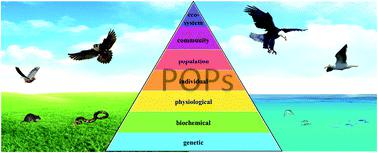当前位置:
X-MOL 学术
›
Environ. Sci.: Processes Impacts
›
论文详情
Our official English website, www.x-mol.net, welcomes your feedback! (Note: you will need to create a separate account there.)
Ecotoxicology of persistent organic pollutants in birds
Environmental Science: Processes & Impacts ( IF 5.5 ) Pub Date : 2021-1-18 , DOI: 10.1039/d0em00451k Yanfen Hao 1, 2, 3, 4, 5 , Shucheng Zheng 1, 2, 3, 4, 5 , Pu Wang 5, 6, 7, 8 , Huizhong Sun 1, 2, 3, 4, 5 , Julius Matsiko 1, 2, 3, 4, 5 , Wenjuan Li 5, 9 , Yingming Li 1, 2, 3, 4, 5 , Qinghua Zhang 1, 2, 3, 4, 5 , Guibin Jiang 1, 2, 3, 4, 5
Environmental Science: Processes & Impacts ( IF 5.5 ) Pub Date : 2021-1-18 , DOI: 10.1039/d0em00451k Yanfen Hao 1, 2, 3, 4, 5 , Shucheng Zheng 1, 2, 3, 4, 5 , Pu Wang 5, 6, 7, 8 , Huizhong Sun 1, 2, 3, 4, 5 , Julius Matsiko 1, 2, 3, 4, 5 , Wenjuan Li 5, 9 , Yingming Li 1, 2, 3, 4, 5 , Qinghua Zhang 1, 2, 3, 4, 5 , Guibin Jiang 1, 2, 3, 4, 5
Affiliation

|
Considering the explosive growth of the list of persistent organic pollutants (POPs), the scientific community is combatting increasing challenges to protect humans and wildlife from the potentially negative consequences of POPs. Herein, we characterize the main aspects and progress in the ecotoxicology of POPs in avian species since 2000. The majority of previous efforts has revealed the global occurrence of high levels of various POPs in birds. Laboratory research and epidemiological studies imply that POPs exert a broad-spectrum of side-effects on birds by interfering with their endocrine, immune and neural system, reproduction, and development, and growth. However, inconsistent results suggest that the potential effects of POP exposure on the physiological parameters in birds are multifactorial, involving a multitude of biological processes, species-specific differences, gender, age and types of compounds. Great progress has been achieved in identifying the species-specific sensitivity to dioxin-like compounds, which is attributed to different amino acid residues in the ligand-binding domain of the aryl hydrocarbon receptor. Besides the conventional concentration additivity, several studies have suggested that different classes of POPs possibly act synergistically or antagonistically based on their concentration. However, ecotoxicology information is still recorded in a scattered and inadequate manner, including lack of enough avian species, limited number of POPs investigated, and insufficient geographical representation, and thus our understanding of the effects of POPs on birds remains rudimentary, although mechanistic understanding of their mode of action is progressing. Particularly, research on what happens to wild bird populations and their ecosystems under POP stress is still unavailable. Thus, our aim is to predict and trace the effects POPs at different biological organization levels, especially from the molecular, cellular and individual levels to the population, community and ecosystem levels because of the limited and scattered information, as mentioned above.
中文翻译:

鸟类中持久性有机污染物的生态毒理学
考虑到持久性有机污染物(POPs)列表的爆炸性增长,科学界正在与日益严峻的挑战作斗争,以保护人类和野生生物免受POPs的潜在负面影响。在这里,我们描述了自2000年以来禽类持久性有机污染物的生态毒理学的主要方面和进展。以前的大多数努力揭示了鸟类中各种持久性有机污染物高水平的全球发生率。实验室研究和流行病学研究表明,持久性有机污染物通过干扰鸟类的内分泌,免疫和神经系统,繁殖,发育和生长,对鸟类产生广泛的副作用。但是,不一致的结果表明,POP暴露对鸟类生理参数的潜在影响是多因素的,涉及许多生物学过程,物种特异性差异,性别,年龄和化合物类型。在鉴定对二恶英样化合物的物种特异性敏感性方面已取得了巨大进展,这归因于芳烃受体配体结合域中的不同氨基酸残基。除常规的浓度加和外,多项研究表明,不同种类的POP基于其浓度可能协同作用或拮抗作用。但是,生态毒理学信息仍然以分散且不充分的方式记录,包括缺乏足够的禽类,所调查的持久性有机污染物数量有限以及地域代表性不足,因此,尽管我们对持久性有机污染物对鸟类的影响有基本的了解,但我们对它的理解仍然是基本的。他们的行动方式正在进步。特别是,仍然没有关于持久性有机污染物胁迫下野生鸟类种群及其生态系统情况的研究。因此,如上所述,由于信息有限和分散,我们的目的是预测和追踪持久性有机污染物在不同生物组织水平上的影响,尤其是从分子,细胞和个体水平到人口,社区和生态系统水平。
更新日期:2021-03-04
中文翻译:

鸟类中持久性有机污染物的生态毒理学
考虑到持久性有机污染物(POPs)列表的爆炸性增长,科学界正在与日益严峻的挑战作斗争,以保护人类和野生生物免受POPs的潜在负面影响。在这里,我们描述了自2000年以来禽类持久性有机污染物的生态毒理学的主要方面和进展。以前的大多数努力揭示了鸟类中各种持久性有机污染物高水平的全球发生率。实验室研究和流行病学研究表明,持久性有机污染物通过干扰鸟类的内分泌,免疫和神经系统,繁殖,发育和生长,对鸟类产生广泛的副作用。但是,不一致的结果表明,POP暴露对鸟类生理参数的潜在影响是多因素的,涉及许多生物学过程,物种特异性差异,性别,年龄和化合物类型。在鉴定对二恶英样化合物的物种特异性敏感性方面已取得了巨大进展,这归因于芳烃受体配体结合域中的不同氨基酸残基。除常规的浓度加和外,多项研究表明,不同种类的POP基于其浓度可能协同作用或拮抗作用。但是,生态毒理学信息仍然以分散且不充分的方式记录,包括缺乏足够的禽类,所调查的持久性有机污染物数量有限以及地域代表性不足,因此,尽管我们对持久性有机污染物对鸟类的影响有基本的了解,但我们对它的理解仍然是基本的。他们的行动方式正在进步。特别是,仍然没有关于持久性有机污染物胁迫下野生鸟类种群及其生态系统情况的研究。因此,如上所述,由于信息有限和分散,我们的目的是预测和追踪持久性有机污染物在不同生物组织水平上的影响,尤其是从分子,细胞和个体水平到人口,社区和生态系统水平。



























 京公网安备 11010802027423号
京公网安备 11010802027423号